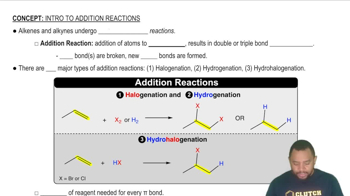Here are the essential concepts you must grasp in order to answer the question correctly.
Alkene Structure
Alkenes are hydrocarbons that contain at least one carbon-carbon double bond (C=C). This unsaturation makes them more reactive than alkanes, allowing them to undergo various addition reactions. The geometry around the double bond is typically trigonal planar, which influences the orientation of the addition products.
Recommended video:
Addition Reactions
Addition reactions involve the addition of atoms or groups to the carbon atoms of the double bond in alkenes, resulting in the formation of saturated compounds. Common types of addition reactions include hydrogenation, halogenation, and hydrohalogenation, each producing different products based on the reagents used. Understanding the mechanism of these reactions is crucial for predicting the products.
Recommended video:
Regioselectivity and Stereochemistry
Regioselectivity refers to the preference of a chemical reaction to yield one structural isomer over others when multiple products are possible. Stereochemistry involves the spatial arrangement of atoms in molecules, which can lead to different stereoisomers. Both concepts are essential for predicting the specific products formed during alkene addition reactions, as they determine how the reactants interact and bond.


